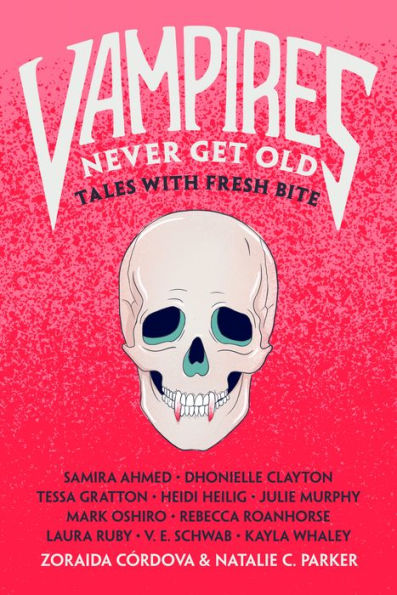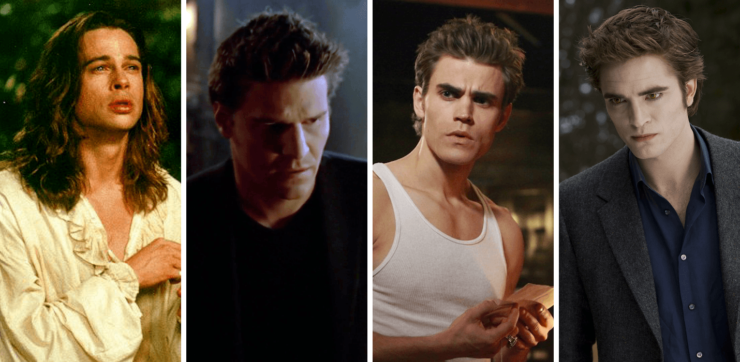I don’t want to shock you, but Edward Cullen wasn’t the first Vegetarian Vampire to take a seat at the table. In fact, Edward comes from a long, storied line of ethically minded bros of the undead who all have one thing in common: while they might want to suck your blood, they’re really gonna try not to.
The Vegetarian Vampire, or leo lamia if you want to get fancy with it, is the one who either abstains from drinking human blood or finds alternative ways of getting it. And it turns out, they’re a staple of the Western Vampire Canon, a trope in their own right!
My relationship with vampires started in the ’80s and, like most kids in the western world, Dracula was my first. Not the real Dracula, but the version I met through cartoons and Sesame Street and my actual favorite The Monster Squad (*insert wolfman’s-got-nards joke here*). Because of this soft intro to the undead, vampires occupied a not-so-scary section of the monster world in my mind. Though the threat was there, it was hidden behind that Bela Lugosi-style caricature that all but obliterated the promise of danger.
I was on the cusp of becoming a teenager when the original Buffy the Vampire Slayer movie came out in 1992, but even that leaned into the idea that vampires were only slightly more dangerous than a bad hair day. For me, vampires didn’t acquire real teeth until Anne Rice’s Interview with the Vampire crashed onto the screen in 1994. It was even later than that when I read the book and others in the series. Suddenly, my imagination was populated with vampires who teetered on the edge of their own humanity, who struggled with and against it, who leaned into their dangerous power and tempted others to follow.
Lestat and Louis quickly became the standard against which I would compare all other vampires for the decades to come. In retrospect, I think it was also the beginning of the Vegetarian Vampire.
Lestat is arguably one of the greatest vampires in all undead imaginings (srsly, fight me), but it is his sadsack companion Louis I want to discuss. Louis, who clung to his humanity with every brooding fiber of his being. Louis, who drank the blood of rats rather than take human life. Louis, whose desperation for real sustenance eventually drove him to drink the blood of a dying child—an act that would haunt him for, well, the rest of his undead days. The key here is that Louis tried to maintain a connection to his humanity by denying himself the thing that vampires require in order to live: human blood.
Don’t worry, I won’t try to claim that Louis was the first to do this (if you have other examples, by all means, add to this list!), but he was the first popular vegetarian vampire.
The next was Angel of Buffy the Vampire Slayer and its titular spin-off Angel. Angel and Louis were certainly cut from the same brooding cloth—they were both turned by blonde bombshells, they both equate suffering with the only emotion that means they are truly alive, and they both seek solace in sewers for some reason—the only difference was that in Angel’s case, he did not struggle with his humanity until he was cursed with a soul. While Angel has been known to imbibe a rat or five in his worst moments, (okay, so technically they’re not a vegetarian vampires, let’s call them free-range) he prefers a butcher or a blood bank where he can discretely source cruelty free hemoglobin.
Around the same time that Angel was skulking around Sunnydale and LA, another vampire was having a similar crisis on the page: Stefan Salvatore of The Vampire Diaries, which was a book series long before it became a glitzy, 8-season epic, also struggled with his lost humanity. In order to make amends for past wrongs (and to contain the bloodlust that threatens to overtake him if he has even a taste of human vintage), Stefan hunts only animals (at least, at first). Basically, he’s a vegetarian because when he’s on the good stuff, he’s an unrestrained serial murderer with fangs.
Finally, we come to the Cullens. Because in vampiretown, all roads lead to Forks.
The Cullens are arguably the most notorious of the Vegetarian Vampire squad, maybe because they’re so sanctimonious about it. They choose not to drink human blood and in doing so, have removed themselves from the greater vampire community. Similar to both Louis and Stefan, they occupy a space that makes them vulnerable in order to not become fully monstrous. And yet! Edward also struggles with a nearly overwhelming bloodlust that puts Bella in danger every time he’s near enough to smell her. To be totally honest, it’s this bridling gothic-hero power that is part of Edward’s charm. Because what’s more appealing than that moment your true love looks deep into your eyes and says, “It’s a good thing I ate breakfast, AMIRTE?”
Okay, but seriously, the real appeal here is that quintessential Beauty and the Beast moment of love being the thing that can overcome even the darkest power/magic/curse. This is at the heart of the vegetarian vampire’s allure—their most basic instinct might be to kill you, but love, that true, epic, ageless kind of love is the only thing that can help them control it.
Taken individually, all of these vamps seem to be locked in intensely personal struggles for their souls. By refusing to drink human blood, they fight off the monster within by maintaining the smallest tether to humanity. But when considered as a group, the pattern is even more interesting. At some point, every one of our vampire heroes has to confront the question of whether or not to drink human blood and when you get right down to it, their main conflict is one of consent.
In Louis’ case, his turmoil over having been turned into a vampire in the first place leaves him horrified by his own choices. Out of utter desperation, he feeds from a dying child (because like attracts like I suppose), loathing himself all the while. But not nearly so much as when Lestat shows up with that same little girl-turned-vampire as a pint-sized gift of eternal regret. Nobody consented to that. Similarly, Angel refuses to drink from Buffy until he is so ill that she forces the issue. Though it saves his life, he’s furious that the choice was made for him and it is this breach of trust that leads Angel to LA and his very own show. Meanwhile, Stefan and Edward are battle buddies who only drink from their lady friends under the most extreme duress and ONLY to save their lives and/or turn them into vampires for better or worse. They do their very best to only drink when consent is clearly given and even then they feel bad about it.
All of these vampiric softbois brood because their eternal life comes with a price: they must either take lives to fuel their own or step onto a path that leads to such reckless disregard for human life that they might take it without even noticing (see: Lestat any day of the week; see also: Angelus aka Angel without a soul; see also: Stefan on a bender; see also: Edward’s murderous brother Jasper).
Buy the Book


Vampires Never Get Old
And here is where the metaphor of the Vegetarian Vampire gets really good. These leading vamps are almost exclusively men, almost exclusively white, almost exclusively straight, hetero, cis, and able-bodied. In short, they’re good guys from good families who rarely have a reason to question their own privilege. But that changes when they’re turned. Suddenly, they’re so far outside the life they knew that the only way they can conceive of to hold onto it is by denying their place in the new hierarchy. They refuse to take something that hasn’t been offered to them, yet, their undead condition requires that they constantly struggle with the temptation.
In other words, becoming vampires was their cue to acknowledge the privilege their position in society affords them by ensuring if/ when they take human blood, they do so with the person’s consent. Their struggle was a struggle precisely because the act of taking was so easy. It was a struggle because all their vampire besties told them they were entitled to it.
And that’s the thing about privilege. It’s easy. It’s access. It’s community.
The vegetarian vampire reminds us that it’s also horrifying.
A few years ago, I started working with my friend and colleague Zoraida Córdova on a vampire anthology called Vampires Never Get Old. Our goal was to gather a collection of vampire tales that took familiar pieces of mythology in new, more inclusive directions. But as the stories arrived, we found that they weren’t only expanding and reimagining the mythology, but they were also engaging in this same conversation. In the hands of our authors the themes surrounding the vegetarian vampire had morphed into a vibrant discussion of agency, transformation, and monstrosity. Of consent, privilege, and colonization.
Monsters have always been a reflection of the things that scare us, but they’re also a reflection of the things we struggle against. The stories we tell about them also tell us about ourselves. And I suspect these creatures of the night have more to show us in the future.
Natalie C. Parker is the author and editor of several books for young adults among them the acclaimed Seafire trilogy. Her work has been included on the NPR Best Books list, the Indie Next List, and the TAYSHAS Reading List, and in Junior Library Guild selections. Natalie grew up in a navy family finding home in coastal cities from Virginia to Japan. Now, she lives with her wife on the Kansas prairie.










